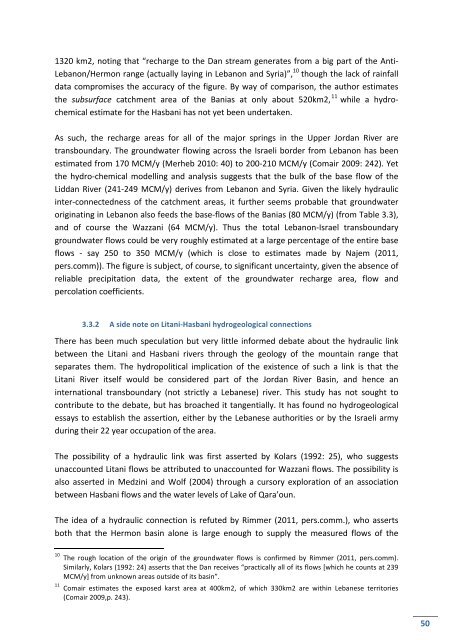Hydro-‐political Baseline of the Upper Jordan River - Ibrahim Abd El Al
Hydro-‐political Baseline of the Upper Jordan River - Ibrahim Abd El Al
Hydro-‐political Baseline of the Upper Jordan River - Ibrahim Abd El Al
You also want an ePaper? Increase the reach of your titles
YUMPU automatically turns print PDFs into web optimized ePapers that Google loves.
1320 km2, noting that “recharge to <strong>the</strong> Dan stream generates from a big part <strong>of</strong> <strong>the</strong> Anti-‐<br />
Lebanon/Hermon range (actually laying in Lebanon and Syria)”, 10 though <strong>the</strong> lack <strong>of</strong> rainfall<br />
data compromises <strong>the</strong> accuracy <strong>of</strong> <strong>the</strong> figure. By way <strong>of</strong> comparison, <strong>the</strong> author estimates<br />
<strong>the</strong> subsurface catchment area <strong>of</strong> <strong>the</strong> Banias at only about 520km2, 11 while a hydro-‐<br />
chemical estimate for <strong>the</strong> Hasbani has not yet been undertaken.<br />
As such, <strong>the</strong> recharge areas for all <strong>of</strong> <strong>the</strong> major springs in <strong>the</strong> <strong>Upper</strong> <strong>Jordan</strong> <strong>River</strong> are<br />
transboundary. The groundwater flowing across <strong>the</strong> Israeli border from Lebanon has been<br />
estimated from 170 MCM/y (Merheb 2010: 40) to 200-‐210 MCM/y (Comair 2009: 242). Yet<br />
<strong>the</strong> hydro-‐chemical modelling and analysis suggests that <strong>the</strong> bulk <strong>of</strong> <strong>the</strong> base flow <strong>of</strong> <strong>the</strong><br />
Liddan <strong>River</strong> (241-‐249 MCM/y) derives from Lebanon and Syria. Given <strong>the</strong> likely hydraulic<br />
inter-‐connectedness <strong>of</strong> <strong>the</strong> catchment areas, it fur<strong>the</strong>r seems probable that groundwater<br />
originating in Lebanon also feeds <strong>the</strong> base-‐flows <strong>of</strong> <strong>the</strong> Banias (80 MCM/y) (from Table 3.3),<br />
and <strong>of</strong> course <strong>the</strong> Wazzani (64 MCM/y). Thus <strong>the</strong> total Lebanon-‐Israel transboundary<br />
groundwater flows could be very roughly estimated at a large percentage <strong>of</strong> <strong>the</strong> entire base<br />
flows -‐ say 250 to 350 MCM/y (which is close to estimates made by Najem (2011,<br />
pers.comm)). The figure is subject, <strong>of</strong> course, to significant uncertainty, given <strong>the</strong> absence <strong>of</strong><br />
reliable precipitation data, <strong>the</strong> extent <strong>of</strong> <strong>the</strong> groundwater recharge area, flow and<br />
percolation coefficients.<br />
3.3.2 A side note on Litani-‐Hasbani hydrogeological connections<br />
There has been much speculation but very little informed debate about <strong>the</strong> hydraulic link<br />
between <strong>the</strong> Litani and Hasbani rivers through <strong>the</strong> geology <strong>of</strong> <strong>the</strong> mountain range that<br />
separates <strong>the</strong>m. The hydropolitical implication <strong>of</strong> <strong>the</strong> existence <strong>of</strong> such a link is that <strong>the</strong><br />
Litani <strong>River</strong> itself would be considered part <strong>of</strong> <strong>the</strong> <strong>Jordan</strong> <strong>River</strong> Basin, and hence an<br />
international transboundary (not strictly a Lebanese) river. This study has not sought to<br />
contribute to <strong>the</strong> debate, but has broached it tangentially. It has found no hydrogeological<br />
essays to establish <strong>the</strong> assertion, ei<strong>the</strong>r by <strong>the</strong> Lebanese authorities or by <strong>the</strong> Israeli army<br />
during <strong>the</strong>ir 22 year occupation <strong>of</strong> <strong>the</strong> area.<br />
The possibility <strong>of</strong> a hydraulic link was first asserted by Kolars (1992: 25), who suggests<br />
unaccounted Litani flows be attributed to unaccounted for Wazzani flows. The possibility is<br />
also asserted in Medzini and Wolf (2004) through a cursory exploration <strong>of</strong> an association<br />
between Hasbani flows and <strong>the</strong> water levels <strong>of</strong> Lake <strong>of</strong> Qara’oun.<br />
The idea <strong>of</strong> a hydraulic connection is refuted by Rimmer (2011, pers.comm.), who asserts<br />
both that <strong>the</strong> Hermon basin alone is large enough to supply <strong>the</strong> measured flows <strong>of</strong> <strong>the</strong><br />
10 The rough location <strong>of</strong> <strong>the</strong> origin <strong>of</strong> <strong>the</strong> groundwater flows is confirmed by Rimmer (2011, pers.comm).<br />
Similarly, Kolars (1992: 24) asserts that <strong>the</strong> Dan receives “practically all <strong>of</strong> its flows [which he counts at 239<br />
MCM/y] from unknown areas outside <strong>of</strong> its basin”.<br />
11 Comair estimates <strong>the</strong> exposed karst area at 400km2, <strong>of</strong> which 330km2 are within Lebanese territories<br />
(Comair 2009,p. 243).<br />
50


